RESEARCH
Learning from Nature: Fusion Energy and
Plasma Research through Dipole Magnetic Fields
The dipole magnetic field-based plasma confinement device was originally proposed by S. Yoshikawa and colleagues as the Princeton Spherator, with plasma experiments reported in 1969 [1]. At that time, the superconducting coil generating the dipole field was supported in vacuum, resulting in significant particle losses due to the support structures. It was optimistically suggested that these losses could be greatly reduced by using a levitated coil without supports. A dipole magnetic field refers to a magnetic field with a north and south pole, like Earth's.
Plasma is a state in which atoms are heated to such high temperatures that their electrons and ions separate. However, due to its high temperature and rapid motion, plasma cannot be contained in ordinary vessels. Thus, researchers devised the idea of magnetic confinement, where charged particles spiral along magnetic field lines. In fusion plasma research, various confinement devices with different magnetic field topologies have been developed, such as the toroidal tokamak, and the dipole configuration is one of them.
Subsequent planetary explorations by Voyager 1 and 2 revealed that many planets in the solar system—including Earth and Jupiter—have dipole magnetic fields. These planets confine plasma within regions called magnetospheres. Despite being influenced by solar wind and magnetic disturbances, these magnetospheres remain stably confined even under high plasma pressure [2–4]. This naturally inspired interest in using dipole magnetic fields for plasma confinement, prompting researchers to look to nature for insights.
Planetary magnetospheres efficiently confine high-pressure plasma within relatively simple dipole magnetic fields. This observation led to the idea of artificially recreating such fields for the development of advanced fusion devices. One pioneer in this field was Hasegawa, who proposed a fusion device using a dipole magnetic field [5]. Theoretical studies by Yoshida and colleagues have shown that fast rotational flows in dipole plasmas play a crucial role in achieving high-beta plasmas—where plasma pressure significantly exceeds magnetic pressure [6–7].
Following these developments, the University of Tokyo built a series of dipole-type devices, starting with Proto-RT, followed by mini-RT and RT-1, which simulates planetary magnetospheres [8]. Similar dipole field plasma devices have since been constructed at institutions such as the Massachusetts Institute of Technology and the Max Planck Institute for Plasma Physics. These experiments have revealed plasma phenomena analogous to those in planetary magnetospheres, contributing to research in fusion and antimatter plasmas.
Fusion devices employing dipole magnetic fields represent an innovative approach inspired by the laws of nature. Through continued research in this area, we aim to accelerate the realization of fusion energy.
Referenced in the University of Tokyo Graduate School of Frontier Sciences publication: 2018, Sōsei Vol. 31 – Frontier Sciences 1 (p. 8)
"Plasma Physics Experiments with the Magnetosphere-Type Plasma Device RT-1: From Laboratory Magnetospheric Plasmas to Fusion Energy Research"


In mainstream fusion research today, including tokamak and helical systems, plasma pressure typically reaches only about one-tenth of the magnetic pressure. In contrast, within Jupiter’s magnetosphere, plasma is confined with remarkable efficiency at pressures comparable to the magnetic pressure itself.
If such high-performance, magnetosphere-like plasmas can be artificially created, they hold strong potential for application in the development of economically viable, next-generation fusion reactors. Numerical simulations of plasma equilibrium in Jupiter’s magnetosphere—taking into account the effect of dynamic pressure from high-speed plasma flows—suggest that ultra-high-beta plasma confinement can be achieved.
In our laboratory experiments, we have successfully reproduced a planetary magnetospheric environment and achieved localized high plasma pressure (with electron beta, βₑ, exceeding 1). We are now pursuing the creation of even higher-performance plasmas.
Magnetospheric Plasma Device RT-1
A superconducting levitation coil is magnetically levitated in a vacuum to generate a dipole magnetic field, simulating a planetary magnetosphere.
The device is used to study self-organization phenomena in magnetosphere-like plasmas.
It enables the stable generation of high-beta plasmas.

- R. Freeman et al., Phys. Rev. Lett. 23, 756(1969).
- S. M. Krimigis et al., Science 206, 977 (1979).
- R. S. Selesnick, R. L. Mcnutt, JGR 92, 15249 (1987).
- L. J. Lanzerotti et al., Science 257, 1518 (1992).
- A. Hasegawa, Comments Plasma Phys. Control Fusion, 147 (1986)
- J. Shiraishi, S. Ohsaki and Z. Yoshida, Phys. Plasmas 12, 092901 (2005).
- Z. Yoshida et al., Plasma Phys. Control. Fusion, 55, 014018
- Y. Ogawa et al., Plasma and Fusion Res. 4, 020 (2009).

In the planetary magnetosphere-type device RT-1, which employs a unique confinement method distinct from the International Thermonuclear Experimental Reactor (ITER) operated by the ITER Organization and JT-60SA of the National Institutes for Quantum and Radiological Science and Technology (QST), it has been revealed that plasmas exist in different confinement regions depending on whether the electrons are high-temperature or low-temperature.
This peculiar plasma structure, forming a double-layered configuration similar to the Van Allen radiation belts found in the Earth’s magnetosphere, was visualized for the first time through millimeter-wave and X-ray diagnostics.
The self-organization and stability of this plasma are maintained by collective behavior of individual ions and electrons. However, the fundamental reasons why the plasma self-organizes in this way and maintains a stable state remain open questions to be addressed in future research.
Solving these challenges is expected to extract universal physics principles independent of the confinement method, thereby contributing to the development of compact, high-performance fusion reactors and addressing unresolved problems in natural plasma phenomena.
There remain several unresolved issues related to plasma self-organization and stability in planetary magnetosphere-type devices.
Some of these challenges are outlined below.
- 1. Elucidation of the Plasma Self-Organization Mechanism
Plasma exhibits collective behavior through interactions among individual ions and electrons. However, the fundamental reasons why plasma self-organizes in this manner and maintains a stable state are not yet fully understood. Clarifying this mechanism could provide valuable insights for achieving more efficient fusion processes.
- 2. Control of Energy Loss in Plasma
Energy loss within the plasma directly affects the efficiency of fusion reactors. It is essential to explore methods to efficiently confine plasma energy and minimize such losses.
- 3. Management of Plasma Instabilities
High-temperature plasmas are subject to various instabilities, such as magnetic islands that provide pathways for energy leakage, particle expulsion caused by wave excitations, and cross-field transport of heat and particles along magnetic field lines. It is crucial to find methods to control these instabilities.
- 4. Development of Compact, High-Performance Fusion Reactors
-
Applying the insights gained from research on planetary magnetosphere-type devices, there is a demand for the development of compact and high-performance fusion reactors.
This is expected to take a significant step toward realizing sustainable energy sources.By addressing these challenges, we anticipate contributing to the advancement of fusion technology and the understanding of unresolved mysteries in nature.
Visualizing Plasma Behavior via
Material Analysis
Plasma Diagnostics


Heating Methods & Diagnostic Instrument Development
- Evaluation of the power absorption of electron cyclotron waves
- Mode-conversion electron heating
- Magnetic beach ion heating
- Non-coherent Thomson scattering
- Coherence imaging spectroscopy
- Wave electric field detection using Pockels effect sensors
- Simulation of wave propagation and absorption in plasma based on wave optics
- Development of measurement data reconstruction methods using machine learning and deep learning (Generative Adversarial Networks (GANs) and Gaussian Processes (GPs))
- ■ Langmuir Probe
-
Electron density, electron temperature, plasma potential
- ■ Soft X-ray Detector
-
High-energy electron energy spectrum

- ■ Visible Spectroscopy
-
Toroidal flow velocity, ion temperature, etc.
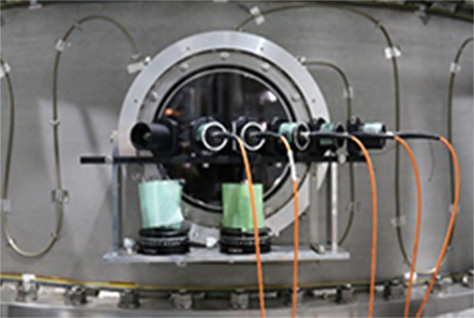
- ■ Magnetic Loop
-
Plasma stored energy β value

- ■ Millimeter-wave Interferometer
-
Electron density, electron density profile

Plasma is considered the fourth state of matter, following solid, liquid, and gas. Fusion plasma, in particular, is extremely hot, with ions and electrons separated from each other. This high-temperature plasma emits electromagnetic waves across a wide range of wavelengths, from short-wavelength X-rays to infrared. Visible electromagnetic waves have wavelengths ranging from violet to red, while X-rays have even shorter wavelengths and are emitted from electrons.
Interestingly, in fusion plasma, the bright regions visible to the eye are not the hottest areas; rather, they are the cooler peripheral regions of the plasma. The transparent core of the plasma is at an extremely high temperature exceeding 100 million degrees Celsius, which is where fusion reactions occur. Therefore, when measuring plasma, it is necessary to visualize it not only using visible light but also by employing various diagnostic methods. This approach clarifies the plasma’s state and also contributes to the study of astrophysical plasmas, which cannot be fully understood by satellite observations.
In our laboratory, we focus on developing new diagnostic instruments and data analysis techniques. For example, by utilizing coherence imaging spectroscopy based on birefringent crystals, we have been able to obtain high-resolution two-dimensional images that are difficult to achieve with conventional spectrometers using diffraction gratings.

The Coherence Imaging Spectroscopy (CIS) system utilizes the Doppler effect of light to measure ion temperature and flow velocity from the spectral broadening and wavelength shift of He⁺ emission lines. Phase difference and spatial displacement of light are generated by two birefringent crystals (BBO), which interfere the light with itself. From the contrast of the interference fringes, the ion temperature is determined, while the displacement of the fringes indicates the flow velocity.
A relay lens system is constructed from the objective lens to a high-sensitivity EMCCD camera for image capture.

Measurement results using the CIS system show a region of elevated ion temperature (Ti) near the resonance layer around Ωci due to ion heating. This result demonstrates the first successful ion heating in a planetary magnetosphere-type device. By successfully visualizing this with the developed CIS system, we have enabled the experimental verification of ion heating.
Generate plasma and heat it to high temperatures
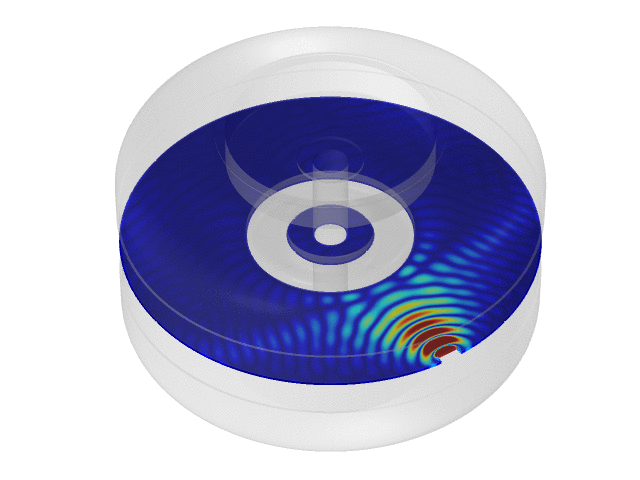
Planetary magnetosphere-type devices like RT-1 possess some of the simplest and most unique magnetic field configurations found in nature. To generate high-temperature plasma, electromagnetic waves in the megahertz to gigahertz frequency range are used. At specific magnetic field strengths, ions and electrons resonate with these waves, and the energy of the propagating electromagnetic waves is transferred to heat the plasma ions and electrons.
Understanding the propagation and absorption of waves within plasma is essential for optimizing plasma heating, and electromagnetic field simulations are a powerful tool for this purpose.
The figure on the right shows the propagation of 2.45 GHz electromagnetic waves used for electron cyclotron resonance heating (ECRH) within the plasma. Electron cyclotron resonance efficiently heats the electrons. It is necessary to consider the refraction, reflection, and absorption of electromagnetic waves by the plasma, as well as reflections from the device walls. The propagation and absorption of electromagnetic waves strongly depend on the plasma’s dielectric properties, which is one of the characteristic features of plasma.
To accurately model the propagation and absorption of electromagnetic waves in fusion plasmas at temperatures approaching 100 million degrees Celsius, it is necessary to use dielectric constants that incorporate weak relativistic effects.
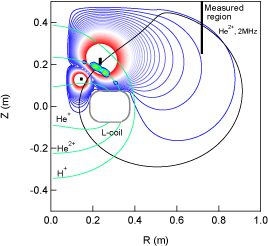
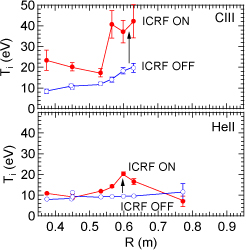
(World’s First!)
- ■ Plasma Wave Heating Physics by Electromagnetic Waves
-
Antenna Model for Ion Cyclotron Heating
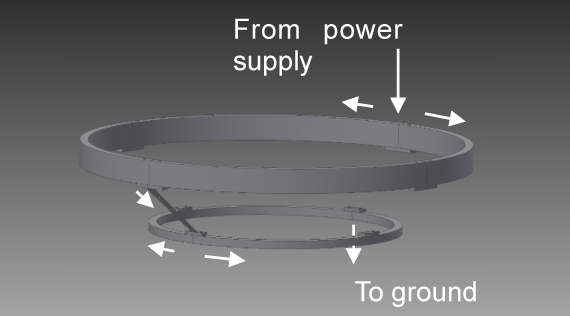
The figure shows electromagnetic field simulations of ion cyclotron resonance heating (ICRH) using 2 MHz electromagnetic waves to heat ions, along with the results from heating experiments. It is necessary to propagate the ion cyclotron waves from the strong magnetic field side, and the antenna design and optimization of the electric field distribution were performed using simulation codes. As a result, we demonstrated ion heating for the first time in the world.
Visualizing Plasma with Advanced Diagnostics
— Charged Particle Tracking Using Collective Thomson Scattering —
In fusion plasma, high-energy α particles are produced through deuterium-tritium fusion reactions. These α particles act as a heating source, enabling the plasma to sustain burning without external heating—this is the power generation scenario for fusion reactors.
Using the millimeter-wave Collective Thomson Scattering (CTS) diagnostic developed in our laboratory, it becomes possible to diagnose the spatial distribution and energy states of α particles within the plasma.
Using the millimeter-wave Collective Thomson Scattering (CTS) diagnostic developed in our laboratory, it becomes possible to diagnose the spatial distribution and energy states of α particles within the plasma.
By applying deep learning with Conditional Generative Adversarial Networks (CGAN) to analyze the measurement data, we have, for the first time in the world, enabled particle mapping in two-dimensional velocity space.
 Schematic Diagram of Electromagnetic Wave Scattering in Plasma Schematic Diagram of Electromagnetic Wave Scattering in Plasma |
 Measurement Results of Ion Velocity Distribution Function Measurement Results of Ion Velocity Distribution FunctionUsing the Collective Thomson Scattering Diagnostic System |
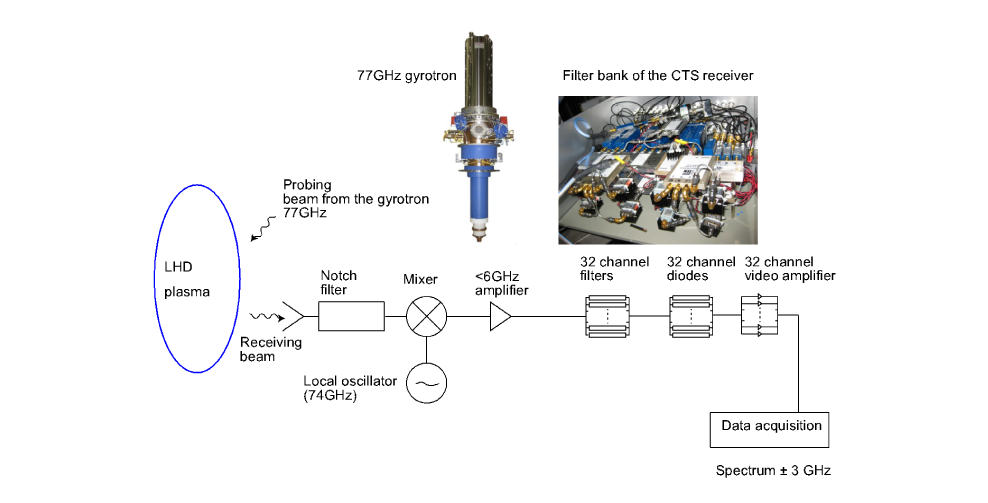 Collective Thomson Scattering (CTS) Diagnostic System Collective Thomson Scattering (CTS) Diagnostic System |
|
 Large Helical Device (LHD) Large Helical Device (LHD) |
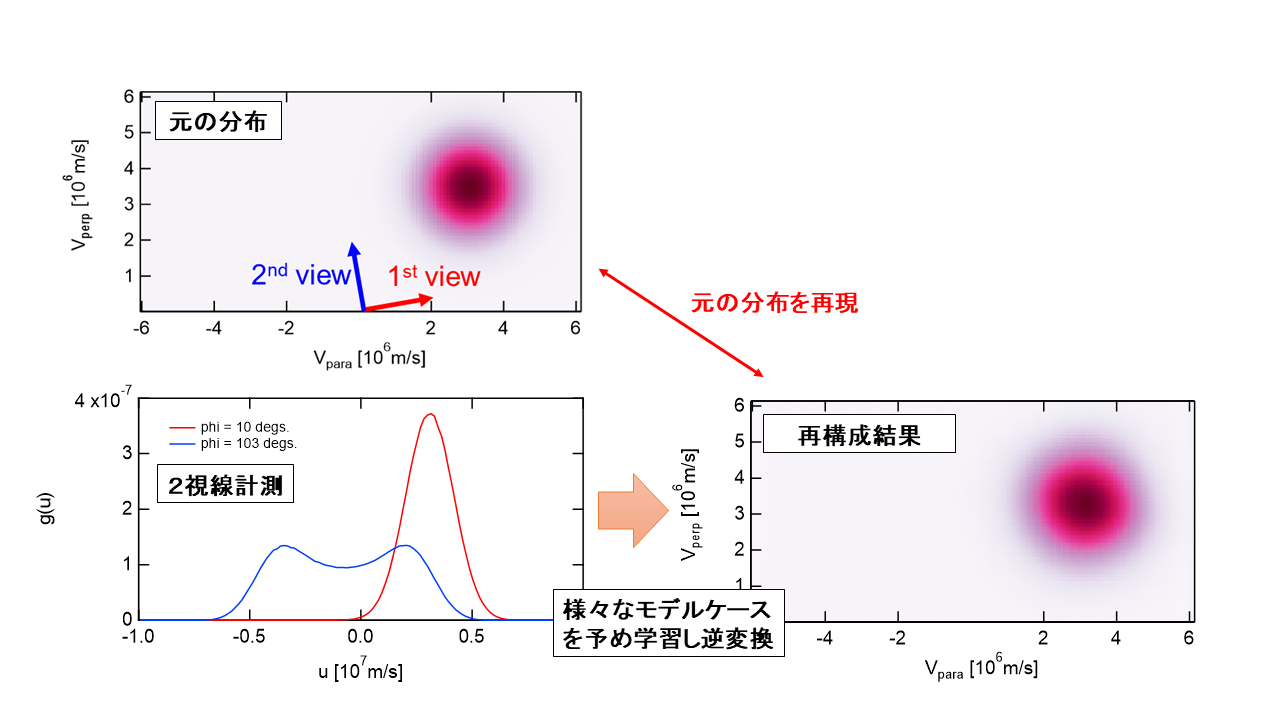 Velocity Space Tomographic Analysis Using Deep Learning (GAN: Generative Adversarial Networks) Velocity Space Tomographic Analysis Using Deep Learning (GAN: Generative Adversarial Networks) |
Promoting International Collaboration and
Interdisciplinary Research
Research on fusion and plasma requires comprehensive knowledge, and international collaborative studies are actively conducted. Our activities are not limited to experiments on the University of Tokyo’s RT-1 device, but also include joint research with the Large Helical Device (LHD) at the National Institute for Fusion Science, the Wendelstein 7-X and ASDEX-Upgrade devices at the Max Planck Institute in Germany, as well as the International Thermonuclear Experimental Reactor (ITER). Interdisciplinary collaborations
大学共同利用機関法人自然科学研究機構 核融合科学研究所/国立大学法人 総合研究大学院大学 物理科学研究科核融合科学専攻
- Burning Plasma Physics
- Millimeter/Submillimeter
- Wave Heating, Diagnostics, and Control
- Turbulent Transport
- Data Science
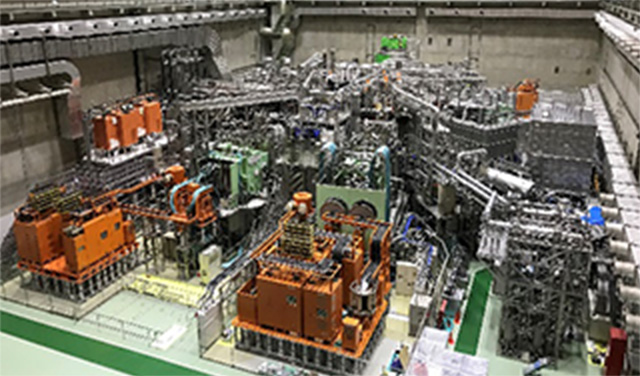
NIFS, the University of Tokyo, Kyoto University, Kyushu University, and others
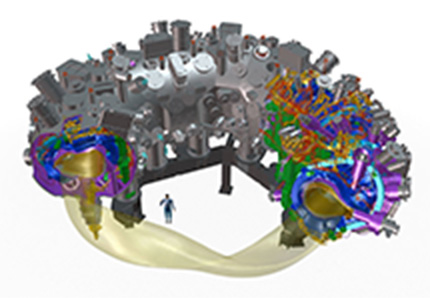
Germany, Max Planck Institute for Plasma Physics (IPP)
Technical University of Denmark (DTU)
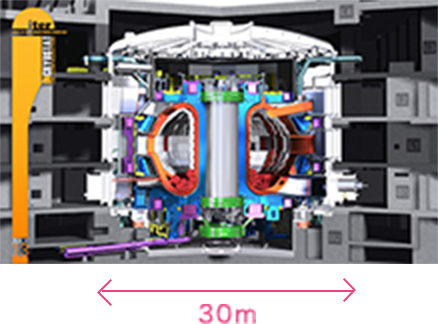
Japan, EU, Russia, China, and others
High-Energy Physics, Accelerators
RIKEN (Japan), Brookhaven National Laboratory (BNL, USA)